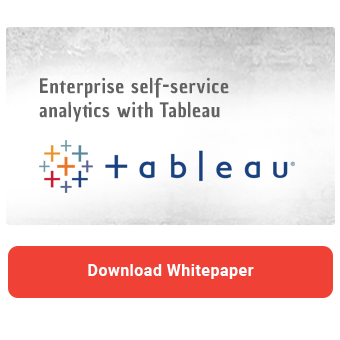The digital transformation is fundamentally changing the decision-making process in businesses. Changes in all areas of the economy are happening faster and more frequently than ever before. To be successful, companies must react quickly and appropriately to the changing requirements of the fast-moving business world. Agile decision-making, however, requires flexibility. Traditional, IT-driven BI is often unable to implement new requirements quickly enough. Delays often lead to late access to information and missed opportunities.
Self-service tools such as Tableau allow users to carry out analyses on their own and to evaluate the relevant data flexibly. The main task of IT, on the other hand, is to ensure that trustworthy and up-to-date data is available to the business departments. Instead of developing dashboards and processing change requests, IT can prioritise the data itself and focus on the issue of data governance, which is at the heart of the self-service environment.
In our whitepaper "Enterprise Self-Service Analytics with Tableau - Dashboarding, Governance and Best Practices", we introduce you to Tableau as a potential self-service solution for your organization. We classify the tool and show how Tableau stands out from its competitors and where its strengths and weaknesses lie. After an overview of the different products and licensing, we go into the actual features for creating Tableau Dashboards and preparing data and provide you with helpful best practices.
In our introduction of the two analytical platforms, Tableau Server and Tableau Online, we also introduce you to the authorization concepts as well as Tableau's various deployment options.
Download the whitepaper and find out if Tableau is a potential frontend solution for you and your organization.
Exploratory analysis using visual analytics
Tableau enables users to translate complex data into understandable visualizations via drag and drop, revealing relationships that were previously hidden. The user-friendly interface invites users to perform exploratory analyses regardless of their technical knowledge and enables them to gain insights from their data in an intuitive way.
Self-service data preparation
Most of the time spent on analysis is dedicated to getting the data into the right shape. With Tableau, business users benefit from the provided tools for preparing data and can combine or join them with just a few clicks. The included tools do not replace a data warehouse, but can nevertheless significantly reduce the effort of data preparation, leaving more time for the actual analysis.
Share your insights with your colleagues
Dashboards only unfold their full potential when they are made accessible to a broad audience. With Tableau Server and Tableau Online, you can give everyone in your organization controlled access to your analyses and data. You can also integrate your dashboards into existing processes and embed them directly into your own corporate portals to avoid media breaks.
Flexible integration into your system landscape
Due to various deployment options, you can seamlessly integrate Tableau into your existing IT landscape. Whether Tableau runs on local computers or in the cloud, it leverages your existing data infrastructure and can be scaled flexibly to keep pace with your business growth.
Whether you are still in the evaluation phase or already use Tableau throughout your company: As a Tableau partner, we are happy to advise you on all aspects of deployment, administration and best practices for effective Tableau Dashboards.


























